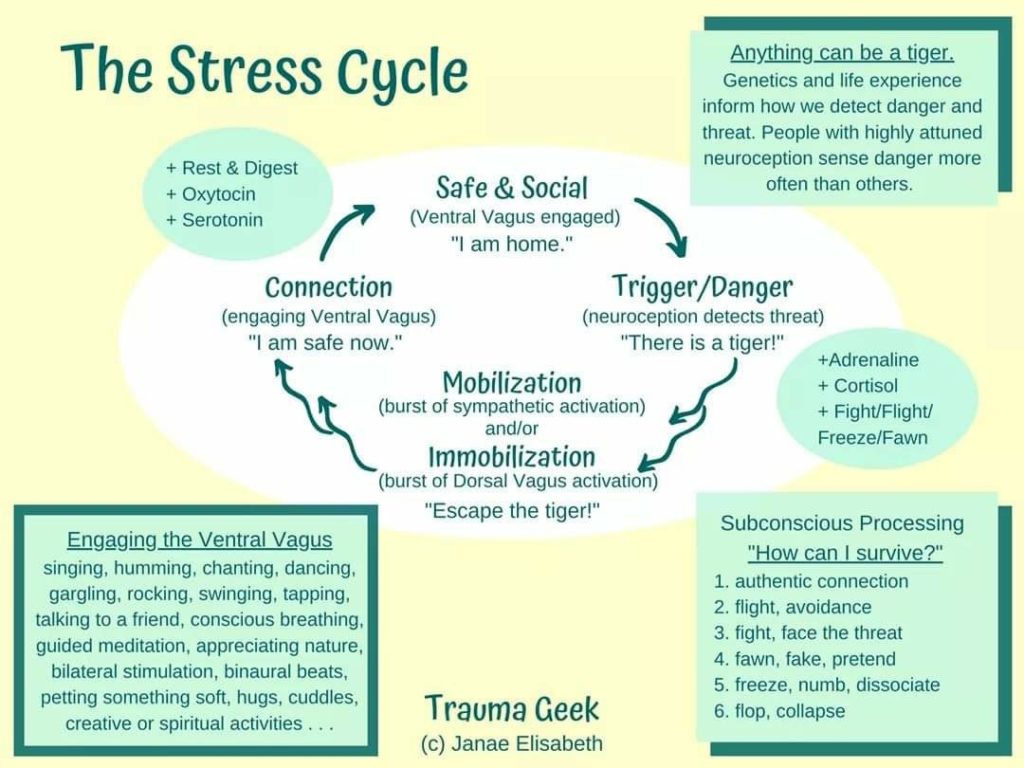Step 1: External stressor
This is the triggering event — the snarky comment from your teenager, the car that almost hits you when you cross the street, the layoffs that are happening at work, or the suspicious looking person walking toward you in the parking lot. This is actually the only part of the stress reaction cycle that your mind and body don’t play a direct role in.
Step 2: Internal appraisal
This comes either just before, during, or just after the actual trigger occurs. Your senses — such as your sight, your hearing, as well as what’s commonly known as your intuition or your gut — take in the information that something’s not right. Your body is exquisitely wired to scan for danger and assess safety. This ability to know when your environment is safe or not-safe is called neuroception, and it happens without your being conscious of it.
When your senses detect something that they perceive to be a threat, they send a signal to your amygdala, which is an almond-sized and -shaped part of your brain that is responsible for processing emotions, particularly strong emotions such as fear and pleasure. When the amygdala is triggered, it then sends a signal to the hypothalamus and the pituitary gland, two other sections of the brain responsible for maintaining homeostasis (a fancy word for “balance”) in the body. They communicate with the rest of the body through the autonomic nervous system, the part of your nervous system that regulates the many processes that occur without your conscious awareness, such as your heart rate, blood pressure, metabolism, respiration, and sleep.
Step 3: Physiological response
Once the hypothalamus and the pituitary receive the call that there’s danger present, they activate the sympathetic nervous system, which is the half of the autonomic nervous system that rules the flight or fight response. They do this by cueing the adrenal glands, which are located right above your kidneys in your lower back, to release stress hormones such as adrenaline and cortisol. The flight or fight response stimulates the cardiovascular system (accelerating the heart rate and diverting blood to the extremities) and the musculoskeletal (priming you to be able to get out of there or to stay and fight).
Whenever the SNS is activated, it means the other half of the autonomic nervous system — the parasympathetic nervous system, which governs the “rest and digest” functions of the body — is suppressed, because they can’t both be activated at the same time. As a result, your immune system and digestive systems are given the “stand down” signal and you are left in a state of hyperarousal.
Up to this point, much of the stress reaction cycle is outside your control, although if you typically exist in a state of hyperarousal because of some of the things that happen farther down the stress reaction cycle, you can have a larger physiological response, with more stress hormones released and a bigger impact on the major systems of the body. It’s really about what happens after this point that determines how much stress you’re under at any given time and how big of a response you’ll have to each successive stressor.
Step 4: Internalization
This is where your response to stress starts to become something that you are at least partially aware of. You may notice that your heart is racing, your stomach is upset, or your back is aching. And then you may start to worry about how you feel and how well or how poorly you perceive yourself to be handling the stress.
his is when you may start thinking things like, Just calm down, Why is this happening?, or, Nothing ever works out for me! These types of thoughts can lead to mental symptoms such as worry, anxiety, or dread. Any of these thought patterns are unpleasant, and a desire to not feel the emotional effects of those thoughts leads to the next step in the cycle.
Step 5: Maladaptive coping
Once you start to notice that you are in physical and/or emotional distress, you will choose to do something to alleviate that discomfort. What methods you choose in this moment dictate whether the stress response lessens, or whether it gets worse.
Whether you realize it or not, you have a habitual response to stress. And for the overwhelming majority of us, this habitual response isn’t actually helpful. The technical term for a response that doesn’t relieve the triggering problem is maladaptive. Nearly everyone alive on the planet engages in at least one maladaptive coping mechanism in the face of stress, and most of us have several that we turn to regularly.
Maladaptive coping mechanisms can rely on outside substances, such as food, alcohol, cigarettes, caffeine, pharmaceutical or recreational drugs. Or, they may be more behavioral — perhaps you pour yourself into your job and overwork, or you distract yourself with mindless media and constantly checking your phone, or you become hyperactive and just can’t seem to sit still. Or your reactions may have an emotional component and you jump to anger, worry, or overwhelm.
Whichever maladaptive coping mechanism you choose, the irony is that the thing you’re hoping will help make you feel better actually makes you feel worse — typically, much worse. They perpetuate the physiological stress response in the body so that you stay in a hyperaroused state — which means that you will subconsciously perceive more potential stressors of greater danger because your sympathetic nervous system stays on high alert and it takes less stimulation from the amygdala, hypothalamus, and pituitary to spring in to action. In addition, all those high-calorie comfort foods, alcoholic drinks, cigarettes, and drugs have physical side effects that can push your body from homeostasis into full-on breakdown.
Dr. Samartano
H/T Jason Mileham Counselling
